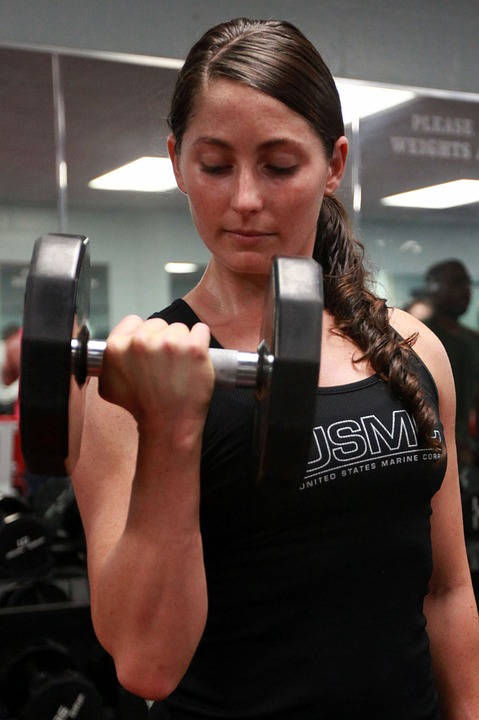5 Myths About Bulking Up vs. Getting Toned
5 Myths About Bulking Up vs. Getting Toned
April 01, 2016 at 2:19 PM

If you’re like a lot of people, you think there are two basic ways in which exercise (and weight training in particular) can affect the body: by bulking it up or slimming it down.
There are two main myths which are far too common in the conventional wisdom on the subject. The first is that weight training is best for bulking up, while cardiovascular exercise is better for getting trim. The second is that when doing any kind of strength training, performing fewer repetitions with higher weight will result in bigger muscles while more reps with lighter weights will tone. Neither is exactly true, and quite a few other misconceptions arise from them.
Let’s take a look at some of the most common myths surrounding the subject and what the truth really is.
Myth #1: Weight Training is for Bulking Up, Cardio is for Trimming Down
This is one of the most widespread and pernicious fitness myths out there. People think that lifting weights or other forms of strength training will cause their muscles to get bigger and thus make them look less lean than they would otherwise.
In fact, for most people increased muscle size and density will result in a higher resting metabolism and aid in fat loss, leading to a much trimmer look overall. Besides, bulking up like a bodybuilder or strongman requires a very specific, highly caloric diet as much as a strength training regimen.
What’s more, an excess of cardio exercise like running without strength training or sufficient calorie intake can actually result in muscle loss. A lot of people want to trim down, but few want to be all skin and bones.
In short, any good workout plan, whether it’s for weight loss or overall fitness, requires strength training in addition to cardio, not one or the other.
Myth #2: More Reps with High Weight Bulks Up, Fewer Reps with Lighter Weight Tones
There’s a certain common sense wisdom this this myth which probably accounts for much of its staying power. On the other hand, it’s simply not true. Research, like a 2010 study out of Canada’s McMaster University, has found that weight and repetitions aren’t as important as their effects: the important thing is working your muscles to the point of fatigue. You can bulk up with lighter weights just the same as heavy ones, as long as you lift until you simply can’t lift anymore.
So if you want to get a good muscle workout, but you’re afraid of grunting, straining, and even injuring yourself, just reach for a lighter weight and be sure to perform reps until fatigue sets in.
Myth #3: Women Shouldn’t (or Can’t) Lift Weights

The myth that lifting weights always leads to bulking up unfortunately results in many women neglecting strength training in their fitness routines. They fear that lifting weights will make them look big, bulky, or even too masculine.
The fact is that not only is strength training just as important for women as it is for men, it’s absolutely crucial. Weight training for women increases strength and fitness, improves metabolism and immunity, fights heart disease and high blood pressure, and has other benefits as well. One particular advantage for women is that strength training has been shown to fight the effects of osteoporosis and age-related bone loss, which affect women at higher rates than men.
As for the idea that women aren’t strong enough for weightlifting, the less said the better. While it’s true that men have higher testosterone levels than women and generally more muscle mass, women are every bit as capable of lifting weights. Everyone, men and women, should regularly exercise every major muscle in the body (not just vanity muscles like abs, pecs, and glutes).
Myth #4: Some Exercises Build “Long, Lean Muscles” Instead of Bulky Ones
Simply put, this myth is debunked by the fact that nothing you can do will make your muscles any substantially longer or shorter. Muscles are attached to bones and joints at different positions, and their length is determined by the distance between those points. Easy!
The idea that some exercises, like yoga or Pilates, create “long, lean” muscles instead of bulky ones is rooted in many peoples’ aversion to looking too big or fat. These kinds of exercises have a much to recommend them, but longer muscles aren’t included.
Another point is that all muscle is by definition lean, and if more lean muscle if your fitness goal, strength training is the way to go.
Myth #5: Muscle Turns to Fat if You Stop Lifting Weights
Myth #5: Muscle Turns to Fat if You Stop Lifting Weights
This myth does have some seed of truth. Like we said above, gaining muscle increases the body’s metabolism naturally. So if you stop lifting weights and begin to lose muscle mass without changing your diet to compensate there’s a good chance you will put on some fat.
That doesn’t mean the muscle actually turns into fat, however. The two are completely different tissues, and one can’t “become” another any more than bone could turn into skin.
Conclusion
If you’re looking to lose weight and get fit, weightlifting or other forms of resistance training are absolutely essential. It increases metabolism, encourages fat loss, and have numerous other health benefits to boot.
Unless you’re working out with a very specific routine involving incredibly high weight and truly heroic calorie consumption, “bulking up” isn’t something you should have to worry about. Lift weights, stay active, eat right, and you should be fine. (Those potbellied Olympic powerlifters you’ve seen aren’t big around the middle because they lift, but because they aren’t concerned about staying trim.)
For more information about diet plans and personal training for weight loss and fitness in Connecticut, get in touch with Medical Weight Loss Solutions in Wallingford by calling (203) 269-8000.


